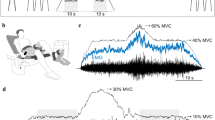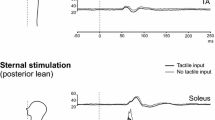Summary
In a visual reaction time task, human subjects superimposed isometric ballistic contractions on a maintained activity in the soleus or anterior tibial muscle. Since there were good reasons to believe that the supraspinal motor commands for the ballistic contractions were independent of those for the background activity, the interaction between the motor commands for the ballistic and for the steady contractions could be studied at the spinal level. If ballistic and steady contractions were in the same direction, the EMG burst and torque changes associated with the ballistic contraction were nearly constant irrespective of the maintained steady flexion force. This was true if a muscle was activated to about 5% of its maximum force as the soleus muscle during plantar flexions and if it was activated to about 40% of its maximum force as the anterior tibial muscle during dorsal flexions. If ballistic and steady contractions were in opposite directions the torque changes related to the ballistic contraction increased linearly with the background activity. This relation was caused by a reduction in antagonist activity starting about 50 ms before the agonist EMG burst and not by an increased agonist burst, the latter remaining independent of background activity. These results imply that the input — output relationship of the motoneuronal pool is nearly linear. The functional basis of this relation is the size principle which is valid during continous and ballistic contractions. The number of motor units recruited for the ballistic contraction is adjusted according to their force such that the contraction amplitude remains constant.
Similar content being viewed by others
References
Benati M, Gaglio S, Morasso P, Tagliasco V, Zaccaria R (1980a) Anthropomorphic robotics. I. Representing mechanical complexity. Biol Cybern 38:125–140
Benati M, Gaglio S, Morasso P, Tagliasco V, Zaccaria R (1980b) Anthropomorphic robotics. II. Analysis of manipulator dynamics and the output motor impedance. Biol Cybern 38:141–150
Bernstein N (1967) The coordination and regulation of movements. Pergamon Press, London
Burke D (1986) The contribution of spindle afferents to altered states of muscle tone. Proc Int Union Physiol Sci 16:253
Carter MC, Shapiro DC (1984) Control of sequential movements: evidence for generalized motor programs. J Neurophysiol 52:787–796
Crone C, Hultborn H, Jespersen B (1985) Reciprocal Ia inhibition from the peroneal nerve to soleus motoneurones with special reference to the size of the test reflex. Exp Brain Res 59:418–422
Day BL, Marsden CD, Obeso JA, Rothwell JC, Traub MM (1982) Manual motor function in a deafferented man. J Physiol 320:23–24P
Day BL, Dick JPR, Marsden CD, Thompson PO (1986) Differences between electrical and magnetic stimulation of the human brain. J Physiol 378:36P
Denier Van der Gon JJ, Thuring JP (1965) The guiding of human hand-writing movements. Kybernetik 2:145–148
Evarts EV (1974) Sensorimotor cortex activity associated with movements triggered by visual as compared to somesthetic inputs. In: Schmitt FO, Worden FG (eds) The neurosciences third study program. MIT Press, Cambridge, pp 327–337
Gandevia SC, McCloskey DI (1977a) Effects of related sensory inputs of motor performances in man studied through changes in perceived heaviness. J Physiol 272:653–672
Gandevia SC, McCloskey DI (1977b) Changes in motor commands as shown by changes in perceived heaviness, during partial curarisation and peripheral anaesthesia in man. J Physiol 272:673–689
Ghez C, Martin JH (1982) The control of rapid limb movement in the cat. III. Agonist-antagonist coupling. Exp Brain Res 45:115–125
Gottlieb GL, Agarwal GC, Stark L (1970) Interactions between voluntary and postural mechanisms of the human motor system. J Neurophysiol 33:365–381
Gottlieb GL, Agarwal GC (1971) Effects of initial conditions on the Hoffman reflex. J Neurol Neurosurg Psychiat 34:226–230
Hallett M, Shabani BT, Young RR (1975) EMG analysis of stereotyped voluntary movements in man. J Neurol Neurosurg Psychiat 38:1154–1162
Hefter H, Hummelsheim H, Freund HJ (1985) Is there a silent period in EMG activity before rapid isometric changes in force levels? Neurosci Lett Suppl 22:S128
Hess CW, Mills KR, Murray NMF (1987) Responses in small hand muscles from magnetic stimulation of the human brain. J Physiol 388:397–419
Hoffmann P (1934) Die physiologischen Eigenschaften der Eigenreflexe. Ergeb Physiol 36:15–108
Hufschmidt HJ, Hufschmidt T (1954) Antagonist inhibition as the earliest sign of a sensori-motor reaction. Nature 174:607
Hultborn H, Meunier S, Pierrot-Deseilligny E, Shindo M (1987) Changes in presynaptic inhibition of Ia fibres at the onset of voluntary contraction in man. J Physiol 389:757–772
Katz D (1951) Gestalt Psychology. Methmen, London
Kawahats K, Miyashita M (1983) Electromyogram premotion silent period and tension development in human muscle. Exp Neurol 82:287–302
Kots YM (1969) Supraspinal control of the segmental centres of muscle antagonists in man. I. Reflex excitability of the motor neurones of muscle antagonists in the period of organization of voluntary movement. Biofizika 14:167–172
Lacquaniti F, Soechting JF (1982) Coordination of arm and wrist motion during a reaching task. J Neurosci 2:399–408
Lashley KS (1951) The problem of serial order in behavior. In: Jeffres LA (ed) Cerebral mechanisms in behavior. Wiley, New York, pp 112–146
Lippold OCJ (1952) The relation between integrated action potentials in a human muscle and its isometric tension. J Physiol 117:492–499
McCloskey DI, Gandevia S, Potter EK, Colebatch JG (1983) Muscle sense and effort: motor commands and judgements about muscular contractions. In: Desmedt JE (ed) Motor control mechanisms in health and disease. Raven Press, New York, pp 151–167
Meinck H-M, Benecke R, Meyer W, Höhne J, Conrad B (1984) Human ballistic finger flexion: uncoupling of the threeburst pattern. Exp Brain Res 55:127–133
Milner-Brown HS, Stein RB (1975) The relation between the surface electromyogram and muscular force. J Physiol 246:549–569
Morasso P, Mussa Ivaldi FA (1982) Trajectory formation and handwriting: a computational model. Biol Cybern 45:131–142
Pew RW (1974) Human perceptual motor performance. In: Kantowitz BH (ed) Human information processing: tutorials in performance and cognition. Erlbaum, New York, pp 1–39
Rüegg DG, Eichenberger A (1983) Detection of reaction time by an adaptive filter based on the least squares fit. Electroencephal Clin Neurophysiol 56:256–258
Rüegg DG, Riedo R, Krauer R (1985) Superposition of ballistic movements on steady contraction. Experientia 41:834
Sanes JN, Jennings VA (1984) Centrally programmed patterns of muscle activity in voluntary motor behavior of humans. Exp Brain Res 54:23–32
Schmidt RA (1976) The schema as a solution to some persistent problems in motor learning theory. In: Stelmach GE (ed) Motor control issues and trends. Academic Press, New York, pp 41–65
Simoyama M, Tanaka R (1974) Reciprocal Ia inhibition at the onset of voluntary movements in man. Brain Res 82:334–337
Terzuolo CA, Viviani O (1979) The central representation of learned motor patterns. In: Talbot RE, Humphrey DR (eds) Posture and movement. Raven Press, New York, pp 113–121
Terzuolo CA, Viviani P (1980) Determinants and characteristics of motor patterns used for typing. Neuroscience 5:1085–1103
Van Galen GP (1980) Handwriting and drawing: a two stage model of motor behavior. In: Stelmach GE, Requin J (eds) Tutorials in motor behavior. North Holland, Amsterdam, pp 567–578
Viviani P, Terzuolo L (1980) Space-time invariance in learned motor skills. In: Stelmach GE, Requin J (eds) Tutorials in motor behavior. North-Holland, Amsterdam, pp 525–533
Wacholder K (1928) Willkürliche Haltung und Bewegung. Erg Physiol 26:568–775
Yabe K (1976) Premotion silend period in rapid voluntary movement. J Appl Physiol 41:470–473
Author information
Authors and Affiliations
Rights and permissions
About this article
Cite this article
Rüegg, D.G., Bongioanni, F. Superposition of ballistic on steady contractions in man. Exp Brain Res 77, 412–420 (1989). https://doi.org/10.1007/BF00274999
Received:
Accepted:
Issue Date:
DOI: https://doi.org/10.1007/BF00274999




